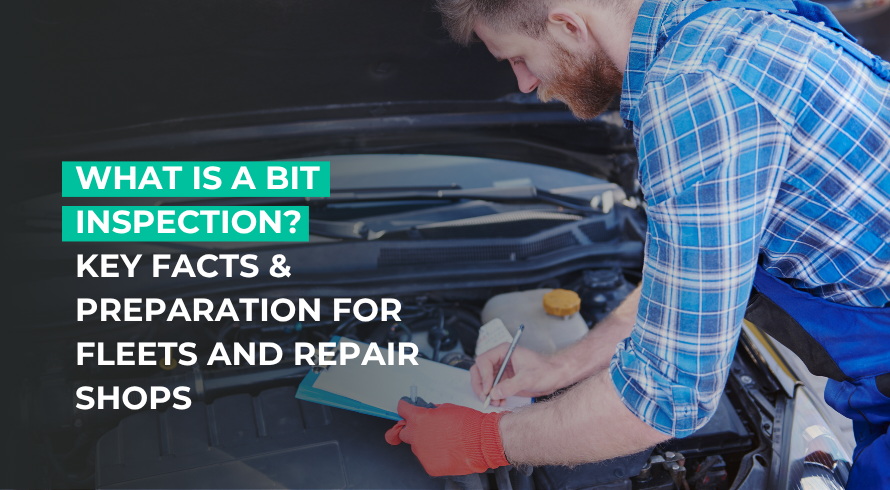In general, a fleet operator must be compliant with the laws of the state. A BIT inspection is not just a safety check but a special legal requirement. Let’s deep dive into what a BIT inspection is and its importance and get your fleet ready for this inspection.
What is a BIT inspection?
A BIT inspection is the required safety check for commercial vehicles. Biennial Inspection of Terminals is mandated by the California Highway Patrol (CHP). This inspection is for the maintenance of vehicles that ensures safety for road operation. The vital elements of an inspection are
- Check to ensure the steering system is smooth and responsive for vehicle control.
- Braking system abuse and functionality checks, including leaks.
- Wheels & tires checked for overall tire condition, tread depth, and inflation.
- Mirrors are positioned for visibility in terms of conditions and alignment.
- Windshield wipers to ensure they keep visibility clear in bad weather.
It’s usually a 90-day inspection or for six months or two years, depending on the compliance history. Not achieving compliance will impose penalty fines, nonoperation of the vehicle, or suspension from driving operations.
Why BIT Inspection?
1. Safety
BIT inspection is important for the safety of both driver and road users. It helps address potential issues and prevent accidents from mechanical failures.
2. Legal compliance
An important part of being a commercial vehicle operator is following state regulations. Avoiding the checklist for BIT inspections can be expensive, legally. Increased scrutiny from regulatory bodies causes interruptions in business operations.
3. Maintenance practices
Fleet operators recognize and fix mechanical problems timely manner because of regular BIT Inspections. This typically saves money and time on costly repairs and downtime. It even contributes to the lifespan of well-maintained vehicles.
Which vehicles are subject to BIT inspection?
Some specific vehicles undergo BIT inspection. Such categories are listed below:
- Trucks having a gross vehicle weight rating (GVWR) of over 10,000 lbs
- Passenger buses or vehicle designed to transport more than 10 passengers
- Vehicles transporting hazardous materials
- Tow trucks and school transportation vehicles
Most likely, you have to comply with BIT standards if your fleet has the above types of vehicles.
BIT vs DOT inspections: Key differences
A DOT inspection or more commonly, a Department of Transportation inspection, indicates a complete investigation of commercial vehicles. Agencies conduct inspections at checkpoints or weigh stations. Such inspections ensure that the vehicles are safe for operation and meet federal safety standards.
Both BIT and DOT inspections, however, are related to safety but are controlled by different authorities and serve different scopes.
Feature | BIT Inspection (California) | DOT Inspection (Federal) |
Who enforces it? | California Highway Patrol (CHP) | Federal Motor Carrier Safety Administration (FMCSA) |
Vehicle Types | California-based commercial vehicles | Interstate commercial carriers |
Frequency | Every 90 days, 6 months, or 2 years (varies) | Annually or randomly during roadside stops |
Scope | Terminal-based inspections | Vehicles, drivers, or hours-of-service logs |
Jurisdiction | State (California only) | Federal (nationwide) |
Who can perform a BIT inspection?
BIT inspections are not performed just by anyone. The technician is required to meet California qualification standards that usually include:
- Experience with heavy-duty commercial vehicles
- Understanding all brake systems, steering, lighting, and safety points
- Understanding CHP inspection forms and documentation protocols
How to prepare before your BIT inspection?
Here are a few best practices to pass BIT inspection:
1. Conduct pre-trip and post-trip inspections daily
Catching issues early helps prevent violations and makes sure that your vehicle is road-ready all the time.
2. Keep an updated maintenance log
Having accurate records will show inspectors that your fleet is steadily maintained and conforms to the requirements.
3. Use digital inspection reports to flag issues early
Generate reports using digital vehicle inspection software that highlight the issue clearly and build transparency with fleet customers.
4. Schedule a mock BIT inspection every few months
Mock inspections usually prepare you for gaps you would possibly find before a true audit. They also help to ensure routine compliance behavior.
5. Train staff to recognize and report safety issues
Empowered employees can address problems before they become violations, improving overall safety.
How often should auto repair customers schedule inspections?
BIT Inspections
Fleets that operate within California should undergo regular inspections. Modern diagnostic equipment and vehicle test instruments are being used to inspect fleets in repair shops to ensure that everything is in the clear. BIT inspections, for example, are completed by a heavy-duty trucks company in California every 90 days. This can avoid issues that may surprise an organization during a terminal review.
DOT Inspections
Regardless of whether the customer is a state or federal operator or both, everyone should do DOT inspections. Anything can happen unscheduled and roadside inspections can occur anytime, which makes it necessary for regular maintenance.
Wrapping up
A BIT inspection isn’t only a legal requirement: it’s also a promise to keep the roads safe. How? By staying organized, equipped with the proper tools, and partnering with certified professionals. Thus, your shop or fleet can stay ahead of inspections and avoid the headaches of compliance down the road.
FAQs
How much is the BIT inspection in California?
The cost of BIT inspection in California differs from that of other states, for fleets or types of fleets being inspected. But costs typically run from $300 to $1,000.
What documents should I have ready for my BIT inspection?
You will need records for vehicle maintenance, driver records (e.g., licenses, medical certificates), inspection reports, and proof of required safety training. Keep organized and up to date with these.
What are the common violations or problems during a BIT Inspection?
Common violations in BIT inspections are worn brakes, broken lights, tire problems, and incomplete maintenance records.
How can owners prevent these infractions?
The effective inspection of vehicles on a regular basis, timely repair, and the maintenance of precise, up-to-date documentation are the most effective ways to prevent such violations.








